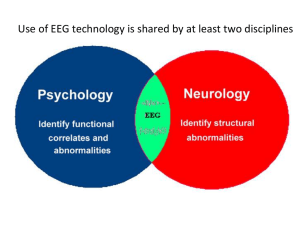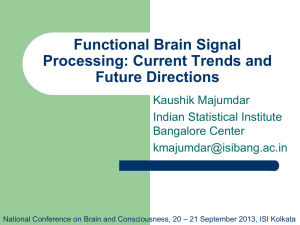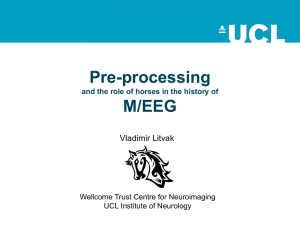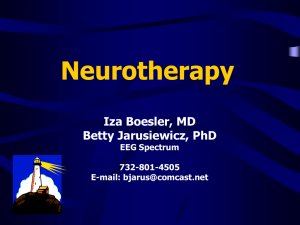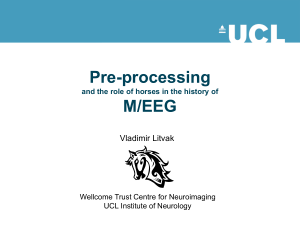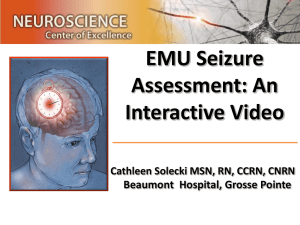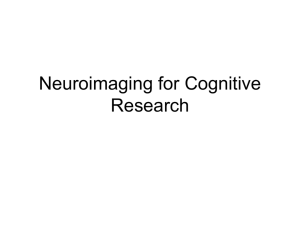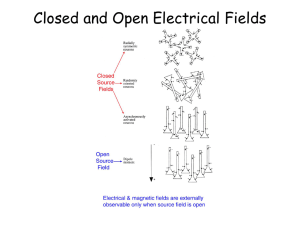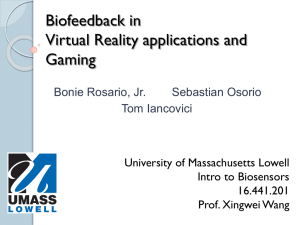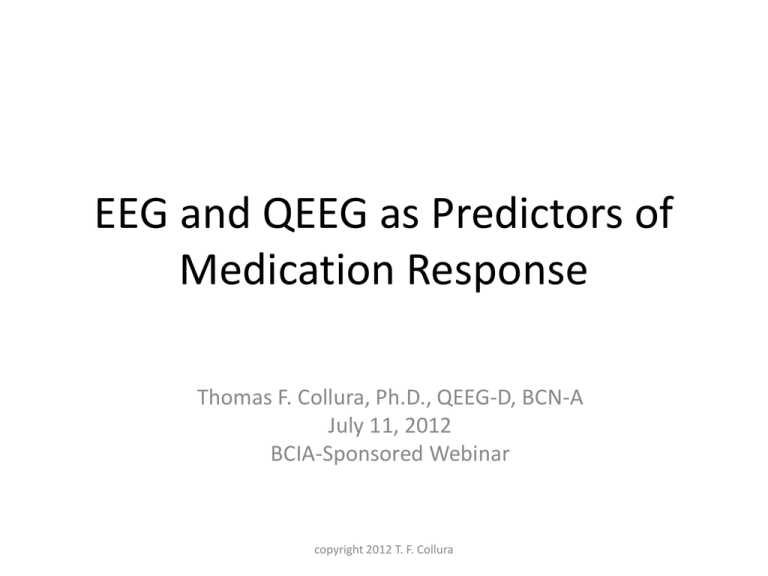
EEG and QEEG as Predictors of
Medication Response
Thomas F. Collura, Ph.D., QEEG-D, BCN-A
July 11, 2012
BCIA-Sponsored Webinar
copyright 2012 T. F. Collura
Overview
• Factors Influencing EEG
• EEG Considerations re: medication for:
– ADD/ADHD
– Depression
– Migraines
• General Recommendations
copyright 2012 T. F. Collura
Factors Influencing EEG
copyright 2012 T. F. Collura
Concentration/Relaxation Cycle
copyright 2012 T. F. Collura
Phenotypes
•
•
•
•
•
•
•
•
•
•
•
Diffuse Slow
Focal Abnormalities, not epileptiform
Mixed Fast & Slow
Frontal Lobe Disturbances – excess slow
Frontal Asymmetries
Excess Temporal Lobe Alpha
Spindling Excessive Beta
Generally Low Magnitudes
Persistent Alpha
“Epileptiform” (requires visual inspection of EEG waveforms)
Faster Alpha Variants, not Low Voltage (requires live z-score
for peak frequency)
• + Diffuse Alpha deficit
copyright 2012 T. F. Collura
Common EEG Deviations
• Depression
– Asymmetric frontal alpha
– Also beta excess or deficit variants
• OCD
– Excess orbitofrontal, temporofrontal alpha
• ADHD
– Frontal slowing, frontal theta, excess central alpha
– Also low-voltage variants
copyright 2012 T. F. Collura
Drugs and EEG
copyright 2012 T. F. Collura
EEG changes due to medications
• Opioids / Cannabis / PCP / Antidepressants
– Increase slow wave activity
• Barbiturates
– Rhythmic 18 to 26 Hz activity
• Neuroleptics / Tranquilizers
– Increase coherence, decrease beta
• Anxiolytics
– Decrease alpha, increase beta
• SSRI’s
– Increase fronto-central beta
copyright 2012 T. F. Collura
Atypical Antipsychotics
• Dopamine and Serotonin agonist
• Side effects: constipation, extrapyramidal,
sedation, tremor, restlessness
• Anecdotal reports of seizures, convulsions
• Arora and Arndorfer (2007) reported twitching,
spells with Aripiprazole (Abilify)
• EEG revealed “generalized epilepsy,” “seizure
activity” in 13 YO male
• http://www.ncbi.nlm.nih.gov/pmc/articles/PMC2
880927/
copyright 2012 T. F. Collura
General Principles
•
•
•
•
•
Record, classify EEG and/or QEEG
Identify particular markers or traits
Associate with likely mechanisms
Consider effects of drugs on EEG
Assess likelihood of positive outcome for
– Medication
– Neurofeedback
– Other Therapies
copyright 2012 T. F. Collura
ADD/ADHD
•
•
•
•
•
At least 5 subtypes identified
Distinct EEG signatures
Prognostic for EEG Biofeedback
Prognostic for Stimulant Effectiveness
May point to alternative medications
copyright 2012 T. F. Collura
Depression
• Two basic forms:
– Left/Right Frontal Asymmetry
• Davidson, Rosenfeld, Baehr
– Localized or General Beta Excess/Deficit
• Hirshberg / Brown / Tufts / Harvard
copyright 2012 T. F. Collura
Anxiety
• Various EEG manifestations
– Excess beta
– Excess alpha
– Alpha deficit
copyright 2012 T. F. Collura
General EEG-Based Pharmacotherapy
• Phenotype-Based
– Arns et al. ADD/ADHD subtyping
• QEEG-Based
– DeBattista, Hoffman, CNS Response
copyright 2012 T. F. Collura
Migraines
• Walker (2011) compared EEG with
• Medication Effectiveness
• EEG Biofeedback Effectiveness
copyright 2012 T. F. Collura
Bolwig et al. (2007)
copyright 2012 T. F. Collura
Arns et al. (2012)
copyright 2012 T. F. Collura
Arns et al. (2012)
• ADHD patients with excess frontal theta EEG
power and excess frontal alpha EEG power are
more likely to respond to stimulant medication
• Low-voltage EEG occurs more often in ADHD than
in controls
• These three subgroups reflect “lower and more
instable vigilance regulation”
• Contrast to “vigilance auto-stabilization (Hegerl,
Sander) which are less responsive to stimulants
copyright 2012 T. F. Collura
Arns et al. (2012)
• Another subgroup: excess beta or beta
spindling (Arns, Chabot, Serfonetin, Clarke)
• Lack of improvement on impulsivity and
inattention in response to stimulants.
• Slowed individual Alpha Peak Frequency (iAPF)
also do not respond to stimulant medication.
• Non-specific trait; also non-responsive to
antidepressants and rTMS
copyright 2012 T. F. Collura
Arns et al. (2012)
copyright 2012 T. F. Collura
Arns et al.
(2012)
copyright 2012 T. F. Collura
Arns et al. (2012)
copyright 2012 T. F. Collura
DeBattista et al. (2010)
copyright 2012 T. F. Collura
DeBattista et al. (2010)
copyright 2012 T. F. Collura
DeBattista et al. (2010)
copyright 2012 T. F. Collura
DeBattista et al. (2010)
copyright 2012 T. F. Collura
DeBattista et al. (2010)
copyright 2012 T. F. Collura
Iosifescu (2011)
copyright 2012 T. F. Collura
Pizzagalli (2001)
copyright 2012 T. F. Collura
Walker (2011)
copyright 2012 T. F. Collura
Walker (2011)
copyright 2012 T. F. Collura
Walker (2011)
copyright 2012 T. F. Collura
Walker (2011)
copyright 2012 T. F. Collura
Summary
• ADD/ADHD
– Subtyping, differential response to stimulants
– Slow-wave variants respond to stimulants
• Depression
– Frontal Asymmetry type responds to antidepressants
– Avoid SSRI’s when excess or spindling beta present
• Migraines
– Medication of limited long-term value
– EEG can be used to select NF
copyright 2012 T. F. Collura
References
• Arns, M., Gunkelman, J., Breteler, M., & Spronk, D. (2008)
EEG phenotypes predict treatment outcome to stimulants
in children with ADHD. Journal of Integrative Neuroscience,
7(3), 421-38.
• Arns, M. Gunkelman, J., Olbrich, S., Sander, C., & Hegerl, U.
(2011) EEG vigilance and phenotypes in neuropsychiatry:
implications for intervention. In R. Coben and J. Evans
(Eds.). Neurofeedback and Neuromodulation Techniques
and Applications. Amsterdam: Elsevier.
• Arns, M., Drinkenburg, W., & Kenemans, J.L. (2012) The
effects of qeeg-informed neurofeedback in ADHD: an openlabel pilot study. Appl Psychophysiol Biof. March 2012.
published online.
copyright 2012 T. F. Collura
References
• Lansbergen, M., Arns, M., van Dongen-Boomsma, M.,
Sprink, D., & Buitelaar, J.K. (2011) The increase in
Theta/Beta ratio on resting state EEG in boys with
attention-deficit/hyperactivity disorder is mediated by
slow Alpha peak frequency. Progress in NeuroPsychopharmacology & Biological Psychiatry, 35, 4752.
• Sander, C., Arns, M., Olbrich, S., & Hegerl, U. (2010).
EEG-Vigilance and response to stimulants in pediatric
patients with attention deficit/hyperactivity disorder.
Clinical Neurophysiology, 121, 1511-1518.
copyright 2012 T. F. Collura
References
• Bares, M., Brunovsky, M., Kopecek, M., Novak, T., Stopkova, P.,
Kozeny, J., et al. (2007). Changes in QEEG prefrontal cordance as a
predictor of response to antidepressants in patients with treatment
resistant depressive disorder: A pilot study. Journal of Psychiatric
Research, 41(3-4), 391-325.
• Bares, M., Brunovsky, M., Kopecek, M., Novak, T., Stopkova, P.,
Kozeny, J., et al. (2008). Early reduction in prefrontal Theta QEEG
cordance value predicts response to venlafaxine treatment in
patients with resistant depressive disorder. European Psychiatry,
23(5), 350-355.
• Benedetti, F., Colombo, C., Pirovano, A., Marino, E., & Smeraldi, E.
(2009). The catechol-o-methyltransferase val(108/158)met
polymorphism affects antidepressant response to paroxetine in a
naturalistic setting. Psychopharmacology, 203(1), 155-60.
copyright 2012 T. F. Collura
References
• Bruder, G.E., Sedoruk, J.P., Stewart, J.W., McGrath, P.J.,
Quitkin, F.M., & Tenke, C.E. (2008).
Electroencephalographic Alpha measures predict
therapeutic response to a selective serotonin reuptake
inhibitor antidepressant: Pre- and post-treatment
findings. Biological Psychiatry, 63(12), 1171-7.
• Bruder, G.E., Steward, J.W., Tenke, C.E., McGrath, P.J.,
Leite, P., Bhattacharya, N., et al. (2001).
Electroencephalographic and perceptual asymmetry
differences between responders and nonresponders to
an SSRI antidepressant. Biological Psychiatry, 49(5),
416-25.
copyright 2012 T. F. Collura
References
• Chabot, R.J., di Michele, F., Prichep, L., & John,
E.R. (2001). The clinical role of computerized EEG
in the evaluation and treatment of learning and
attention disorders in children and adolescents.
The Journal of Neuropsychiatry and Clinical
Neurosciences, 13(2), 171-86.
• Chabot, R.J. & Serfontein, G. (1996). Quantitative
electroencephalographic profiles of children with
attention deficit disorder. Biological Psychiatry,
40(10), 951-63.
copyright 2012 T. F. Collura
References
• Clarke, A.R., Barry, R.J., McCarthy, R., & Selikowitz, M.,
(2001a). Age and sex effects in the EEG: Differences in two
subtypes of attention-deficit/hyperactivity disorder. Clinical
Neurophysiology, 112(5), 815-26.
• Clarke, A.R., Barry, R.J., McCarthy, R., & Selikowitz, M.,
(2001b). EEG-defined subtypes of children with attentiondeficit/hyperactivity disorder. Clinical Neurophysiology,
112(11), 2098-2105.
• Clarke, A.R., Barry, R.J., McCarthy, R., Selikowitz, M., Brown,
C.R., & Croft, R.J. (2003) Effects of stimulant medication on
the EEG of children with attention-deficit/hyperactivity
disorder predominantly inattentive type. International
Journal of Psychophysiology, 47(2), 129-37.
copyright 2012 T. F. Collura
References
• Cook, I.A., Leuchter, A.F., Morgan, M., Witte, E.,
Stubbeman, W.F., Abrams, M., et al. (2002). Early
changes in prefrontal activity characterize clinical
responders to antidepressants.
Neuropsychopharmacology, 27(1), 120-31.
• DeBattista, C., Kinrys, G., Hoffman, D., Goldstein,
C., Zajecka, J., Kocsis, J., et al. (2010) The use of
referenced-EEG (rEEG) in assisting medication
selection for the treatment of depression.
Journal of Psychiatric Research, 45(1), 64-75.
copyright 2012 T. F. Collura
References
• Iosifescu, D.V. (2008). Prediction of response to
antidepressants: Is quantitative EEG (QEEG) an
alternative? CNS Neuroscience & Theraputics, 14(4),
263-265.
• Iosifescu, D.V. (2011) Electroencephalography-derived
biomarkers of antidepressant response. Harvard
Review of Psychiatry, 19(3), 144-54.
• Iosifescu, D.V., Greenwald, S., Devlin, P., Mischoulon,
D., Denninger, J.W., Alpert, J.E., et al. (2009). Frontal
EEG predictors of treatment outcome in major
depressive disorder. European
Neuropsychopharmacology, 19(11), 772-7.
copyright 2012 T. F. Collura
References
• Johnstone, J. & Lunt, J. (2011) Use of quantitative EEG to predict
therapeutic outcome in neuropsychiatric disorders. In In R. Coben
and J. Evans (Eds.). Neurofeedback and Neuromodulation
Techniques and Applications. Amsterdam: Elsevier.
• Korb, A.S., Hunter, A.M., Cook, I.A., & Leuchter, A.F. (2009). Rostral
anterior cingulate cortex Theta current density and response to
antidepressants and placebo in major depression. Clinical
Neurophysiology, 120: 1313-9.
• Leuchter, A.F., Cook, I.A., Marangell, L.B., Gilmer, W.S., Burgoyne,
K.S., Howland, R.H., et al. (2009). Comparative effectiveness of
biomarkers and clinical indicators for predicting outcomes of SSRI
treatment in major depressive disorder: Results of the BRITE-MD
study. Psychiatry Research, 169(2), 124-31.
copyright 2012 T. F. Collura
References
• Pizzagalli, D., Pascual-Marqui, R.D., Nitchke, J.B.,
Oakes, T.R., Larson, C.L., Abercrombin, H.C. et al.
(2001) Anterior cingulate activity as a predictor of
degree of treatment response in major
depression: Evidence from brain electrical
tomography analysis. The American Journal of
Psychiatry, 158(3), 405-15.
• Pizzagalli et al. (2001) Anterior cingulate activity
as s predictor of treatment resonse in major
depression: evidence from brain electrical
tomography. Am J. Psychiatry 158(3) 405-415.
copyright 2012 T. F. Collura

